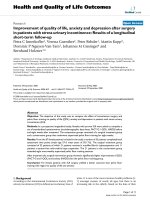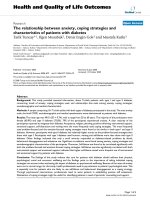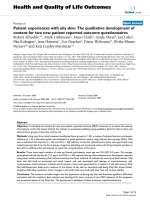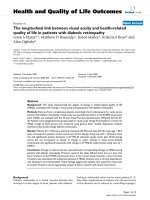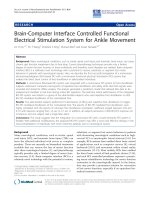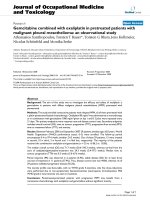Báo cáo hóa học: " Nanostructured Biomaterials with Controlled Properties Synthesis and Characterization"; pptx
Bạn đang xem bản rút gọn của tài liệu. Xem và tải ngay bản đầy đủ của tài liệu tại đây (528.01 KB, 6 trang )
NANO EXPRESS
Nanostructured Biomaterials with Controlled Properties
Synthesis and Characterization
Eugenia Teodor Æ Simona Carmen Lit¸escu Æ
C. Petcu Æ Mihaela Mihalache Æ Raluca Somoghi
Received: 29 August 2008 / Accepted: 9 February 2009 / Published online: 6 March 2009
Ó to the authors 2009
Abstract Magnetic nanoparticles were obtained using an
adjusted Massart method and were covered in a layer-by-
layer technique with hydrogel-type biocompatible shells,
from chitosan and hyaluronic acid. The synthesized nano-
composites were characterized using dynamic light
scattering, transmission electron microscopy, and Fourier
transformed infrared spectroscopy. Biocompatibility of
magnetic nanostructures was determined by MTT (3-
[4,5-dimethylthiazol-2-yl]-2,5-diphenyltetrazolium bromide)
cell proliferation assay, swelling tests, and degradation
tests. In addition, interaction of hydrogel-magnetic nano-
particles with microorganisms was studied. The possibility
of precise nanoparticles size control, as long as the avail-
ability of bio-compatible covering, makes them suitable for
biomedical applications.
Keywords Magnetic nanoparticles Á Hydrogels Á
Layer-by-layer technique Á Biocompatibility
Introduction
The association of magnetic nanoparticles with hydrogel
type biopolymeric shells confers to composite material bio-
compatibility and the capacity to retain and deliver
bioactive substances. This is supported by the fact that
hydrogel-magnetic nanoparticles could be controlled by a
magnetic field in order to facilitate their penetration in
target tissues. It is possible to obtain in this way ‘‘smart’’
nanostructured biomaterials, which could support different
biotechnological and biomedical applications. Moreover, it
should be underlined that by this way the main goal of
nanoparticles employment is attained in therapeutics,
namely to improve drug solubility and bioavailability [1],
due to the fact that there is a need to develop suitable drug
delivery systems that distribute the bioactive molecule only
to the site of action, without affecting healthy organs and
tissues [2].
Ferromagnetic nanoparticles applicability in therapeu-
tics had known an increasing interest. They are used either
as contrast [3] and labeling agents [4], or as drug delivery
systems [5–7].
The main aim of the present work was to synthesize
magnetic nanoparticles (NP), with enhanced biocompati-
bility obtained by hydrogel biomaterial covering of
nanoparticles, which preserve the nanometric dimensions,
and moreover are nontoxic and noninteractive with path-
ogen bacteria. The developed nanocomposite material
could be used for medical or biotechnological purposes.
Materials and Methods
Water-dispersible magnetic nanoparticles (MP) were
obtained according to previous studies, using an adjusted
Massart method [8]. Briefly, the magnetic nanoparticles
were precipitated from an aqueous mixture of Fe
2?
and
Fe
3?
salts (1:2 molar ratio), and treated with NH
4
OH at
75 °C. Subsequent to precipitation the magnetic nanopar-
ticles were encapsulated in bio-polymer shells.
E. Teodor (&) Á S. C. Lit¸escu Á M. Mihalache
National Institute for Biological Sciences-Centre of Bioanalysis,
296 Spl. Independentei, Bucharest 6, Romania
e-mail:
C. Petcu Á R. Somoghi
National Institute for Chemistry & Petrochemistry,
202 Spl. Independentei, Bucharest 6, Romania
e-mail: cpetcu@chimfiz.icf.ro
123
Nanoscale Res Lett (2009) 4:544–549
DOI 10.1007/s11671-009-9278-x
Two different biopolymeric materials were tested,
namely chitosan (Chit) from crab shells (Sigma) and
hyaluronic acid (HA) (extract from bovine vitreous, own
extraction method) [9]. Two covering procedures were
performed, namely (i) layer-by-layer coating—using 2%
chitosan solution and 1% hyaluronic acid solution—and
(ii) hybrid polymer coating. The hybrid polymer consisted
of Chit–HA hydrogels obtained by physical mixing of 2%
chitosan solution and 1% HA solution. Different ratios of
chitosan solution and hyaluronic acid solution were
employed in covering magnetic nanoparticles. Size distri-
bution and characterization of bare and encapsulated
magnetic nanoparticles were acquired using dynamic light
scattering (DLS) technique, at room temperature using
Malvern instrument (Nicomp 270, laser source, k
632.8 nm) operating in the range 1 nm–1 lm.
The morphology of the particles was investigated with
transmission electron microscopy (TEM) and confocal
microscopy, using a Philips EM 208, and a confocal
spectral laser scanning microscope (LEICA TCS SP).
The structure of hydrogel coated magnetic nanoparticles
was characterized by Fourier transform infrared spectros-
copy (FT-IR) technique using a Bruker Tensor 27 device.
The swelling tests and degradation tests were performed,
for both bare and covered nanoparticles.
The obtained hydrogel-magnetic nanoparticles (*10 mg
dry weight) were suspended in tubes containing 10 mL of
PBS (pH 7.2 at 20 °C). At a defined time period (3, 6, 12,
24 h, etc.) the excess buffer was carefully removed, using a
magnetic separator and the hydrogel-magnetic nanoparti-
cles were weighed immediately. The swelling capacity was
calculated according to the following equation [10]:
%S ¼
m
w
À m
i
m
i
 100 ð1Þ
where %S is swelling ratio, m
w
is the weight of samples
after swelling test performing (buffer immersion), and m
i
is
initial weight.
Hydrogel-magnetic nanoparticles were suspended into
Falcon tubes containing 10 mL PBS (pH 7.2 at 37 °C). At
predetermining time points, hydrogels were collected with
a magnetic separator and excess buffer was removed from
the tubes. Samples were weighed by using an analytical
balance with ±0.1 mg accuracy. After the equilibration
time of swelling in PBS, the degradation ratio was calcu-
lated according to the following equations [11]:
%D ¼
m
0
À m
t
m
0
 100 ð2Þ
where %D represent degradation ratio, m
0
is the original
weight after equilibration time of swelling in PBS, and m
t
is the weight at time t.
Cytotoxicity of nanostructures was determined by MTT
cell proliferation assay [12], a quantitative, convenient
method to evaluate a cell population’s response to external
factors. The key component is (3-[4,5-dimethylthiazol-
2-yl]-2,5-diphenyl tetrazolium bromide) or MTT. Mito-
chondrial dehydrogenases of viable cells cleave the
tetrazolium ring, yielding purple formazan crystals which
are insoluble in aqueous solutions. The resulting purple
solution is spectrophotometrically measured. An increase
or decrease in cell number results in a concomitant change
in the amount of formazan produced, indicating the degree
of cytotoxicity caused by the test material.
MTT test was done on Vero cells (kidney epithelial cells
from African green monkey). These were seeded into 24-
well plates at a density of 5 9 10
4
cells/well and were
cultured for 24 h in Dulbecco’s modified Eagles medium/
10% FBS (DMEM). After 24 h, the medium was replaced
with different samples obtained from hydrogel-magnetic
nanoparticles (conc. 2–12 ng/cell).
After 2 days exposure of cells to nanoparticles the cells
were washed with phosphate buffer and 500 lL MTT
solution (0.5 mg/mL) was added in each well. The cells
were incubated for 3 h at 37 °C and the formazan crystals
formed in living cells were solubilized in isopropanol.
The absorbance was measured at 570 nm with a Jasco
UV–Vis spectrometer. The viability of the treated cultures
was expressed as a percentage of the control, untreated
cells.
The study of hydrogel-magnetic nanoparticles interac-
tions with microorganisms was performed on Gram-positive
(methicillin resistant Staphylococcus aureus, Listeria mon-
ocytogenes), Gram-negative bacteria (Escherichia coli,
Salmonella enteritidis, Pseudomonas aeruginosa), and yeast
(Candida albicans). The testing of the antimicrobial and
antifungal activity was investigated by a qualitative screen-
ing of the susceptibility spectrum of different microbial
strains to the tested samples by adapted variants of the dif-
fusion method [13].
Results and Discussion
Magnetic nanoparticles were obtained by co-precipitation of
iron oxides. NP from solutions of iron II and III were covered
with successive layers of different chitosan and hyaluronic
acid ratios, both in a layer-by-layer (l-b-l) technique and in a
hybrid polymer covering technique, resulting in different
variants of hydrogel-magnetic nanoparticles.
Thirty-eight variants were tested, some of them, the
most important ones, being presented in Table 1. Sample
22 exemplified in the table was obtained by covering
magnetic nanoparticles with a pre-formed mixture of Chit
Nanoscale Res Lett (2009) 4:544–549 545
123
and HA. Samples 13, 20, and 30 were obtained using three
successive layers of Chit/HA/Chit (l-b-l technique) and
sample 38 was obtained from MP covered with single layer
of chitosan. In order to decide if the obtained nanoparticles
are suitable for biological applications, characterization in
terms of size, size distribution, and morphology were
performed.
Size and Size Distribution of Covered NP
The hydrogel-magnetic nanoparticles were characterized
by DLS and zetametry to determine the size, size distri-
bution, and zeta potential (Table 1). As could be noticed
from the values of the particles sizes (in swelled stage), the
layer-by-layer covering technique with three successive
layers of Chit/HA/Chit seemed to provide the most suitable
nanoparticles dimensions (180–264 nm), ensuring a degree
of covering of the NP and a compact structure. The zeta
potential values alternating from negative to positive val-
ues proved that the NP covering is efficient and, moreover,
the final nanostructures obtained are stable, taking into
account that the values are higher than 30 mV.
Nanoparticles covered with one, or two layers of poly-
mer, and those covered with mixed polymers finally
presented too large dimensions detected by DLS mea-
surements (Table 1).
The synthesized covered magnetic nanoparticles were
subjected to confocal laser microscopy analysis to provide
some images of the covered NP, the results proving that a
high degree of NP spherical conformation is obtained by
l-b-l method with three layers of Chit/HA/Chit (Fig. 1).
The samples obtained by hybrid polymer covering present
clusters and a low degree of dispersion and have micro-
metric dimensions in swelled stage (Fig. 2 and Table 1).
Further studies were done only with samples suitable for
applications in bio-medical area (especially for delivery
systems).
Morphology of Covered NP
The morphology of nanostructures synthesized by l-b-l
technique was studied using TEM. The obtained images
(Fig. 3) demonstrate a homogenous distribution and a
spherical shape of obtained nanostructures, a conclusion
Table 1 Composition and characteristics of some synthesized hydrogel-magnetic nanoparticles
Sample
no.
Sample composition Diameter media
(nm)
Zeta potential
(mV)
Obs.
6 Dispersion of magnetic nanoparticles (MP) 66.9–169.3 (-34)–(-50.6) Magnetic, black
13 20 mL MP ? 10 mL 2% Chit 147–816 3.74–43.7 Magnetic, stable
?10 mL 1% HA 187–444 (-43.7)–7.13
?10 mL 2% Chit 181–263 12.7–47.6
20 20 mL MP ? 1.5 mL 2% Chit 222–816 (-0.23)–41.5 Magnetic, stable
?5 mL 1% HA 241–444 (-3.26)–(-14.7)
?1.5 mL 2% Chit ? INH 240–264 12.7–46.1
22 20 mL MP ? 3 mL [mixed 1% HA and 2% Chit; 1:3 (v:v)] 2289–6237 (-2.5)–(-15)
30 20 mL MP ? 3 mL 2% Chit 1225–2662 (-14.6)–3.74 Magnetic, stable
?3 mL 1% HA 916–1530 (-9.29)–(-19)
?3 mL 2% Chit 254–264 28.9–31.6
38 20 mL MP ? 1 mL 2% Chit 741–816 (-24.8)–41.5
Bold values indicate the appropriate dimensions of nanoparticles \264 nm
Fig. 1 Confocal microscope micrograph of hydrogel-magnetic nano-
particles obtained by layer-by-layer technique (sample 13),
(250 9 250 lm)
546 Nanoscale Res Lett (2009) 4:544–549
123
that agrees to that arising from confocal analysis (Fig. 1).
In addition, the micrographs obtained from TEM (Fig. 3)
show that the dimensions of nanoparticles, bare or encap-
sulated, are between 30 and 50 nm in dried stage. It is
known that nanosized delivery systems should have
dimensions ranging between 1 and 100 nm [14].
Structural Analysis FTIR of Covered NP
The structure characterization of the obtained covered NP
was performed by FTIR. From the obtained spectra being
obvious that the suitable covering of magnetic nanoparticle
surface was performed, the structural pattern of chitosan
and hyaluronic acid was observed on the NP surface. As
could be noticed from Fig. 4 the presence of hydroxyl –OH
and –NH
2
groups from chitosan and HA on the covered
nanoparticles is obvious. The specific bands at the wave
numbers 3200 cm
-1
and 3680 cm
-1
, respectively, with
their confirmation in the region 1790–1520 cm
-1
, are being
easily noticed in the nanostructure spectra. The slight shift
on the wave numbers values registered between chitosan,
respectively HA itself and covered NP it is ascribable to the
link of shells to the magnetic nanoparticles.
Biocompatibility Tests
With the argument of appropriate size, good covering, and
suitable end groups being able to bind an active principle,
several tests of biocompatibility were performed on the
obtained nanostructures, the first step being that of swelling
behavior.
Swelling Test
Experiments showed that the obtained nanostructures had
similar swelling behavior with each other, the swelling
capacity increasing with the enhancement of hyaluronic
acid/chitosan ratio. The obtained swelling capacity for five
types of nanoparticles is presented in Fig. 5, the higher
value of the swelling capacity being obtained after 48 h.
Degradation Tests
The in vitro degradation studies for the encapsulated NP
were performed in phosphate buffer solution for 80 days.
The synthesized hydrogel-magnetic nanoparticles pre-
sented a great stability in neutral media, with respect to our
previous studies about pellicle-type hydrogels degradation
[15]. If for the pellicle-type hydrogels the degradation
percent was between 30 and 50 in 40 days (Fig. 6a), the
nanostructured NP stability increased, the maximum deg-
radation percent attained in 80 days being \2% (Fig. 6b).
Cytotoxicity Tests
The second experiment of biocompatibility concerned the
cytotoxicity tests of nanostructures that were determined
using MTT cell proliferation assay. The tests for in vitro
biocompatibility were performed in triplicates on Vero
cells cultivated with different concentrations of magnetic
Fig. 2 Confocal microscope micrograph of hydrogel-magnetic nano-
particles obtained by hybrid polymer covering technique (sample 22),
(250 9 250 lm)
Fig. 3 Transmission electron microscope micrograph of hydrogel-
magnetic nanoparticles (sample 13)
Nanoscale Res Lett (2009) 4:544–549 547
123
nanostructures (between 2 and 12 ng/cell). As could be
observed from Fig. 7, the obtained nanostructures are
highly biocompatible, no cytotoxicity was detected in cells
cultured after 48 h with highest concentrations of hydro-
gel-magnetic nanoparticles (12 ng/cell), the cell phenotype
being normal (Fig. 7a), and the cell viability about 75%
(Fig. 7b). At higher concentrations (20 ng/cell), the via-
bility decreases, but it maintains over 65% (data not
shown).
Microbiological Tests
The study of the interaction of nanostructures with
microorganisms (Gram-positive, Gram-negative bacteria
Fig. 4 FTIR spectra of layer-
by-layer Chit–HA covered
magnetic nanoparticles; inset
overlaid FTIR spectra of
chitosan and hyaluronic acid
0
0,5
1
1,5
2
2,5
3
3,5
0 24 48 72 96 120 144 168 192 216
swelling capacity (%)
time (h)
13
20
30
MP
38
Fig. 5 Swelling behavior of covered magnetic nanoparticles
0
10
20
30
40
50
60
0 20 40 60 80 100
time, days
degradation, %
CHIT less 65% deacetylated/HA 9:1
CHIT/HA 9:1
CHIT less 65% deacetylated/HA 3:1
CHIT/HA 3:1, sodium citrate
-0,2
0
0,2
0,4
0,6
0,8
1
1,2
1,4
1,6
1,8
0 102030405060708090100
%degradation
time (days)
13 20 30 MP 38
A
B
Fig. 6 a Degradation of Chit/HA hydrogels themselves [pellicle-type
hydrogels were obtained by casting method using mixtures of
different 2% Chit and 1% HA solutions [15]. b Degradation of
Chit–HA hydrogels—magnetic nanoparticles
548 Nanoscale Res Lett (2009) 4:544–549
123
and yeasts) was performed afterward. Using three different
variants to determine the microbial behavior in 24 h, the
same conclusion was drawn, namely the NPs and nano-
structures do not stimulate the growth of microorganisms
(data not shown).
Conclusions
Interest in nanosized drug delivery systems based on
magnetic nanoparticles has increased in the past few years.
Recent studies describe an approach in the formation of a
novel hydrogel nanocomposite with superparamagnetic
property based on magnetic nanoparticles suspension
mixed with different polymers and cyclic oligosaccharide
[16]. Novel magnetic hybrid hydrogels were fabricated by
the in situ embedding of magnetic iron oxide nanoparticles
into the porous hydrogel networks; this magnetic hydrogel
material was found to hold a potential application in
magnetically assisted bioseparation [17].
We obtained hydrogel-magnetic nanoparticles with a
magnetic core (Fe
3
O
4
) encapsulated in layer-by-layer
chitosan–hyaluronic acid hydrogel. The designed nano-
structures were characterized, proving to be suitable to
cellular wall penetration due to their dimensions [14]
(between 180–264 nm in swelled stage, and between 40–
90 nm in dried stage), spherical shape, homogenous dis-
tribution, and swelling capacity.
FT-IR spectroscopy analysis gave evidence about the
magnetic NP encapsulation in biopolymeric layers, the
specific wave numbers for carboxyl-, hydroxyl-, and
amino-groups signals from chitosan and hyaluronic acid
being registered.
Performed biocompatibility tests proved that the
hydrogel-magnetic nanoparticles resulting from our
experiments are biocompatible and relatively inert to
microorganisms, so they are suitable to be used for loading
and delivery of active compounds.
Acknowledgments This work was financially supported by the
National Research and Development Agency of Romania, the Pro-
gram of Excellence in Research (No. 129/2006 RELANSIN CEEX).
References
1. Q.A. Pankhurst, J. Connolly, S.K. Jones, J. Dobson, J. Phys. D
Appl. Phys. 36R, 167 (2003). doi:10.1088/0022-3727/36/13/201
2. R.V. Ulijn, J. Mater. Chem. 16, 2217 (2006). doi:10.1039/b601
776m
3. J.W.M. Bulte, J. Magn. Magn. Mater. 289, 423 (2005). doi:
10.1016/j.jmmm.2004.11.119
4. O.V. Salata, J. Nanobiotechnol. 2, 1 (2004)
5. Z.M. Saiyed, S.D. Telang, C.N. Ramchad, Biomagn. Res.
Technol. 1, 1 (2003). doi:10.1186/1477-044X-1-2
6. T.Y. Liu, S.H. Hu, K.H. Liu, D.M. Liu, S.Y. Chen, J. Control.
Release 20, 228 (2008). doi:10.1016/j.jconrel.2007.12.006
7. D. Guowei, K. Adriane, X. Chen, C. Jie, L. Yinfeng, Int.
J. Pharm. 2, 78 (2007)
8. R. Massart, IEEE Trans. Magn. 17, 1247 (1981). doi:10.1109/
TMAG.1981.1061188
9. E. Teodor, F. Cutas¸, L. Moldovan, L. Tcacenco, M. Caloianu,
J. Biol. Sci. I, 35 (2003)
10. J.S. Mao, H.F. Liu, Y.J. Yin, K.D. Yao, Biomaterials 24, 1621
(2003). doi:10.1016/S0142-9612(02)00549-5
11. Y. Xu, Y. Du, Int. J. Pharm. 250, 215 (2003). doi:10.1016/
S0378-5173(02)00548-3
12. T. Mosmann, J. Immunol. Methods 65, 55 (1988). doi:
10.1016/0022-1759(83)90303-4
13. V. Lazar, V. Herlea, R. Cernat, C. Balotescu, D. Bulai, A. Moraru,
Microbiologie generala (Ed. Univ. din Bucuresti, Bucharest,
2003)
14. O.M. Koo, I. Rubinstein, H. Onyuksel, Nanomedicine 1, 193
(2005)
15. E. Teodor, A. Rugina, G.L. Radu, Rev. Chim. Bucharest 56, 1211
(2005)
16. D. Ma, L.M. Zhang, J. Phys. Chem. B 22, 6315 (2008). doi:
10.1021/jp7115627
17. Y.Y. Liang, L.M. Zhang, W. Jiang, W. Li, Chemphyschem 12,
2367 (2007). doi:10.1002/cphc.200700359
0
20
40
60
80
100
120
control MP sample13sample 20sample 30sample 38
% living cells
% (v/v)
A
B
Fig. 7 a Vero cells morphology after 48 h of cultivation with
hydrogel-magnetic nanoparticles (light microscopy, Giemsa stain,
objective 920). b Biocompatibility/cytotoxicity of obtained nanopar-
ticles cultured 48 h with Vero cells (nanoparticles conc. was 12 ng/
cell). The absorbance at 570 obtained for control was considered
100%. The results for the treated cells were expressed as percentage
from the control, untreated culture (mean value ± SD)
Nanoscale Res Lett (2009) 4:544–549 549
123

